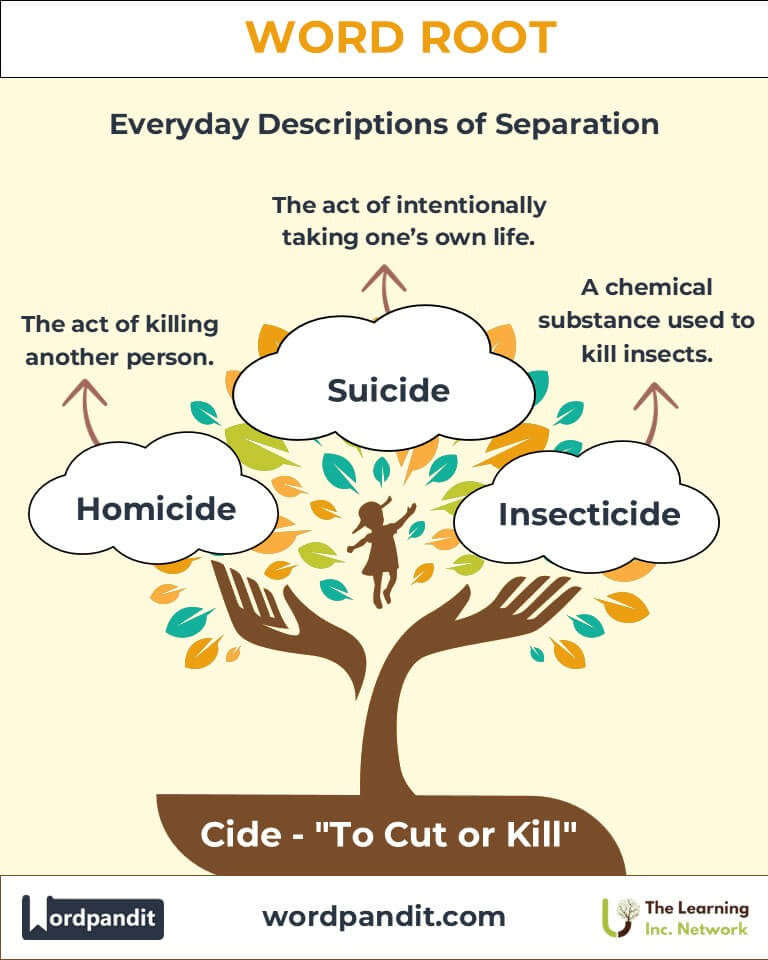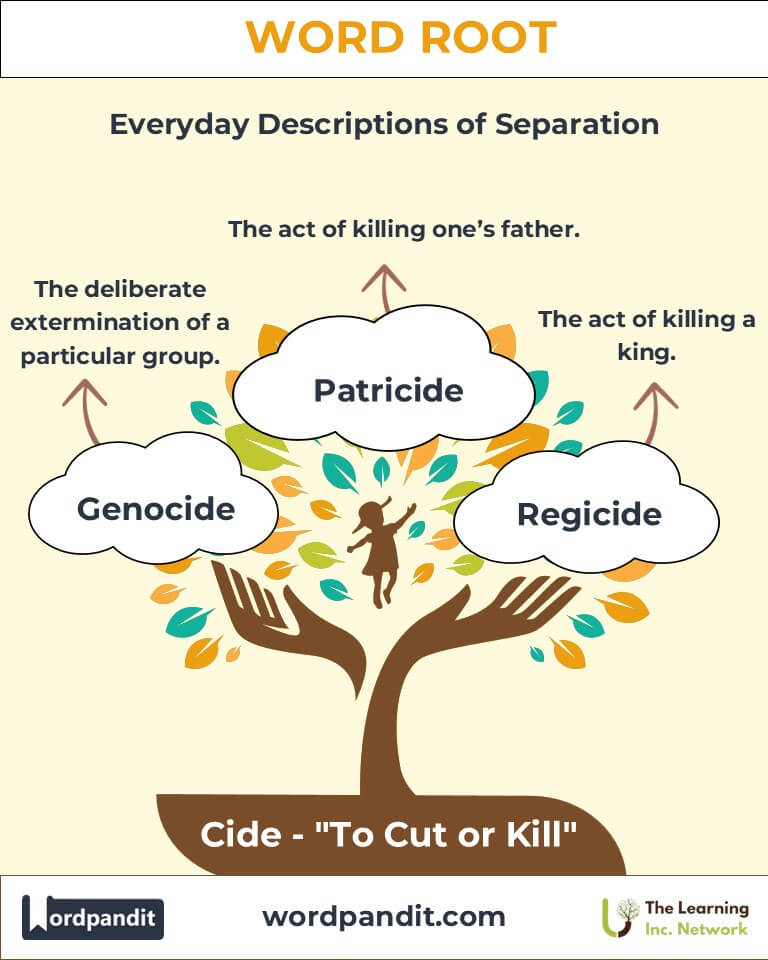Cide: The Root of Actions and Endings
Explore the powerful root "Cide," derived from the Latin word "caedere," meaning "to cut" or "to kill." From "homicide" to "insecticide," this impactful root encapsulates concepts of endings, decisive actions, and transformations across language and fields.

Table of Contents
- Introduction: The Essence of "Cide"
- Etymology and Historical Journey
- Mnemonic: Unlocking the Power of "Cide"
- Common "Cide"-Related Terms
- "Cide" Through Time
- "Cide" in Specialized Fields
- Illustrative Story: "Cide" in Action
- Cultural Significance of the "Cide" Root
- The "Cide" Family Tree
- FAQs about the "Cide" Word Root
- Test Your Knowledge: "Cide" Mastery Quiz
- Conclusion: The Dual Nature of "Cide"
Introduction: The Essence of "Cide"
Have you ever wondered why the word "homicide" means the act of killing another human or how "suicide" encapsulates the tragic act of self-infliction? The root "Cide" carries significant weight, tracing back to the Latin "caedere," meaning "to cut" or "to kill." Its usage has spanned centuries, shaping words that convey deliberate acts of severance or endings in various contexts, including law, agriculture, and medicine.

Etymology and Historical Journey
The word root "Cide" finds its origin in the Latin verb "caedere." Initially used to describe cutting or felling trees, the term evolved to describe acts of killing or putting an end to something. By the Middle Ages, "Cide" was incorporated into English, forming terms like "homicide" and "regicide," often used in legal and political contexts. Its evolution underscores humanity's complex relationship with both creation and destruction.
Mnemonic: Unlocking the Power of "Cide"
Visualize a knight's sword, sharp and decisive, cutting through obstacles. The sword represents the act of severance, the core meaning of "Cide."
Mnemonic Device: “‘Cide’ cuts through endings—decisive and final.”
Common "Cide"-Related Terms
- Homicide (hahm-uh-side): The act of killing another person.
Example: "The detective investigated the homicide with great determination." - Suicide (soo-uh-side): The act of intentionally taking one’s own life.
Example: "Efforts to prevent suicide are essential for mental health advocacy." - Genocide (jen-uh-side): The deliberate extermination of a particular group.
Example: "Genocide is recognized as one of the most heinous crimes against humanity." - Insecticide (in-sek-tuh-side): A chemical substance used to kill insects.
Example: "Farmers rely on insecticides to protect crops from pests." - Patricide (pa-truh-side): The act of killing one’s father.
Example: "In ancient myths, patricide often served as a dramatic turning point."
"Cide" Through Time
- Fratricide (Medieval Era): Describes the killing of one’s sibling, often appearing in royal family disputes.
- Infanticide (Early Modern Period): The act of killing an infant, which reflects historical social and economic challenges.
- Ecocide (Modern Era): Refers to destruction or severe damage to the environment, an emerging legal term in ecological activism.
"Cide" in Specialized Fields
- Law: Regicide (killing of a king) and homicide define specific crimes, highlighting their gravity in legal systems.
- Agriculture: Pesticides (used to kill pests) and herbicides (targeting weeds) are vital for crop protection.
- Psychology and Sociology: Suicide research focuses on prevention, addressing mental health crises globally.
Illustrative Story: "Cide" in Action
In the city of Verida, an ecologist named Lara discovered illegal pesticide use harming local wildlife. Determined to protect the ecosystem, she launched an awareness campaign about the consequences of ecocide. Meanwhile, a local community leader educated farmers about sustainable alternatives. Together, they turned a destructive cycle into a narrative of renewal and hope.
Cultural Significance of the "Cide" Root
The root "Cide" resonates deeply in history and culture. From Shakespearean tragedies involving regicide to modern debates about insecticides’ ecological impact, it highlights themes of power, morality, and consequence. Its linguistic duality—depicting both necessary and tragic endings—reflects humanity’s complex values.

The "Cide" Family Tree
Explore related roots and affixes:
- Caed- (Latin: "to cut")
- Deciduous: Trees that "cut off" leaves seasonally.
- Cid- (Variant)
- Incident: Something that “falls” into a sequence of events.
- Other Related Roots:
- Mort: (Death) Mortal, mortician.
- Noc: (Harm) Noxious, innocuous.

FAQs About the "Chromo" Word Root
Q: What does "Chromo" mean, and where does it originate?
A: "Chromo" means "color" and originates from the Greek word "chroma" (χρῶμα). It was used in ancient Greece to describe the hues observed in nature and art, later influencing modern scientific and artistic terminology.
Q: Why are chromosomes called "chromosomes"?
A: Chromosomes were named for their ability to absorb dyes during microscopic studies. The term combines "chromo" (color) and "soma" (body) to reflect their stained appearance and role in genetics.
Q: What is chromotherapy, and how does it work?
A: Chromotherapy is a wellness practice using colors to balance energy and promote health. For instance, blue is associated with calm, while red is believed to energize. Though not scientifically proven, it remains popular in holistic health approaches.
Q: How does the chromosphere relate to the sun?
A: The chromosphere is a colorful layer of the sun's atmosphere, visible during solar eclipses. It plays a significant role in studying solar energy emissions and atmospheric phenomena.
Q: What does "chromogenic" mean?
A: "Chromogenic" means "producing color." It is commonly used in photography to refer to color film development and in microbiology to describe bacteria identified by their color reactions.
Test Your Knowledge: Chromo Mastery Quiz
1. What does "Chromo" signify?
2. What is a chromosome?
3. What is the chromosphere?
4. Which field uses chromatography?
5. What does chromogenic mean?
Conclusion: The Dual Nature of "Cide"
The root "Cide" illustrates humanity’s power to act decisively, whether for necessity or tragedy. Its presence in language reminds us of the weight of actions and their consequences, urging thoughtfulness and balance. Explore "Cide" and embrace the lessons embedded in its dual nature.












